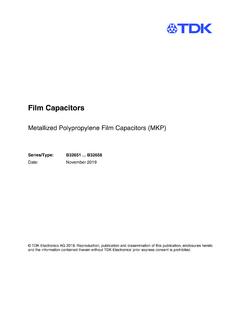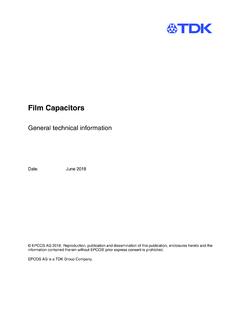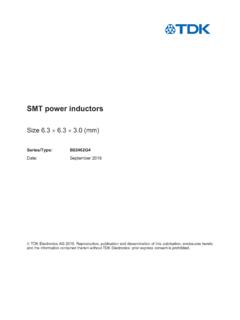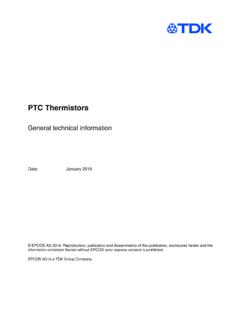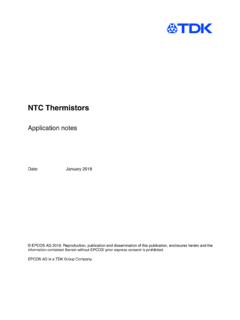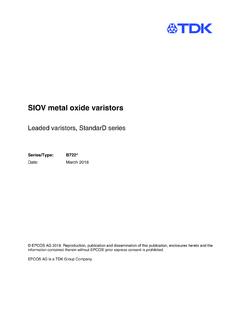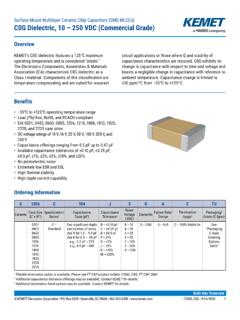Transcription of Aluminum Electrolytic Capacitors - TDK Electronics
1 Aluminum Electrolytic CapacitorsGeneral technical informationDate:$ECEMBER 201 TDK Electronics AG 2019. Reproduction, publication and dissemination of this publication, enclosures heretoand the information contained therein without TDK Electronics ' prior express consent is construction of Aluminum Electrolytic capacitorsAIuminum Electrolytic Capacitors assume a special position among the various types of capacitorssince their principle of operation relies, in part, on electrochemical advantages of Aluminum Electrolytic Capacitors that have led to their wide application rangeare their high volumetric efficiency ( capacitance per unit volume), which enables the produc-tion of Capacitors with up to one Farad capacitance, and the fact that an Aluminum Electrolytic ca-pacitor provides a high ripple current capability together with a high reliability and an excellentprice/performance is the case with all Capacitors , an Aluminum Electrolytic capacitor comprises two electricallyconductive material layers that are separated by a dielectric layer.
2 One electrode (the anode) isformed by an Aluminum foil with an enlarged surface area. The oxide layer (Al2O3) that is built upon this is used as the dielectric. In contrast to other Capacitors , the counter electrode (thecathode) of Aluminum Electrolytic Capacitors is a conductive liquid, the operating electrolyte. Asecond Aluminum foil, the so-called cathode foil, serves as a large-surfaced contact area for pass-ing current to the operating 1 Basic construction of an Aluminum electrolyticcapacitorC CapacitanceF 0 Absolute permittivityAs/Vm rRelative permittivity( for Al2O3)A Capacitor electrode surface area m2d Electrode spacingmThe anode of an Aluminum Electrolytic capacitor is an Aluminum foil of extreme purity. The effec-tive surface area of this foil is greatly enlarged (by a factor of up to 200) by electrochemical etch-ing in order to achieve the maximum possible capacitance values. The type of etch pattern andthe degree of etching is matched to the respective requirements by applying specific technical informationPage 2 of 39 Please readImportant notesandCautions and foils enable very compact Aluminum Electrolytic capacitor dimensions to be achieved andare used almost exclusively nowadays.
3 The electrical characteristics of Aluminum Electrolytic ca-pacitors with plain (not etched) foils are, in part, better, but these Capacitors are considerably larg-er and are only used for special applications 2 Structure of anode foil for high-voltagecapacitors (magnification 300x)Figure 3 Structure of anode foil for low-voltagecapacitors (magnification 400x)The dielectric layer of an Aluminum Electrolytic capacitor is created by anodic oxidation (forming)to build up an Aluminum oxide layer on the foil. The layer thickness increases in proportion to theforming voltage at a rate of approximately nm/V. Even for Capacitors for very high voltages,layer thicknesses of less than 1 m are attained, thus enabling very small electrode is another reason for the high volumetric efficiency achieved ( in comparison to the mini-mum thickness of a paper dielectric, 6 to 8 m).During the forming process the very fine pits of the etched foils will encrust partially in proportionto the forming voltage.
4 Due to this effect, the final operating voltage range must already be takeninto account when the foils are oxide layer constitutes a non-linear voltage-dependent resistance that causes the DC currentto increase more steeply as the voltage increases. A characteristic curve as shown in figure 4 Rated voltageVS= Surge voltageVF= Forming voltageI = DC currentFigure 4 Current-voltage characteristic of analuminum Electrolytic capacitorGeneral technical informationPage 3 of 39 Please readImportant notesandCautions and the forming voltage VFis exceeded, the forming process restarts and large amounts of gasand heat are generated. The same effect, yet on a smaller scale, can already be observed in theknee of the curve. In order to achieve a high degree of operating safety of the capacitor, the ratedvoltage VRis defined as being on the quasi-linear part of the curve. As the capacitor is subjectedto surge voltages VSfor short periods only, this range lies between the rated voltage and the form-ing voltage.
5 The difference between forming voltage and operating voltage, the so-called over-anodization, thus has a substantial effect on the operating reliability of the capacitor. High over-anodization offers the possibility of producing especially reliable Capacitors designated as long-lifegrade "LL" Capacitors to IEC 60384 the Electrolytic Capacitors have a liquid as a cathode, they are also designated as "wet" or"non-solid" Capacitors . The liquid has the advantage that it fills the fine etching pits, therefore opti-mally fitting into the anode two Aluminum foils are separated by paper spacers. The paper serves various purposes, itserves as a container for the electrolyte the electrolyte is stored in the pores of the absorbentpaper and also as a spacer to prevent electric short-circuits, as well as ensuring the required di-electric strength between the anode and cathode 5 Winding construction of an Aluminum Electrolytic capacitorGeneral technical informationPage 4 of 39 Please readImportant notesandCautions and Aluminum Electrolytic capacitor constructed in the way described above will only operate cor-rectly if the positive potential is connected to the formed Al foil (anode), and the negative potentialto the cathode foil.
6 If the opposite polarity were to be applied, this would cause an electrolyticprocess resulting in the formation of a dielectric layer on the cathode foil. In this case strong inter-nal heat generation and gas emission may occur and destroy the capacitor. Secondly, the cath-ode capacitance, which will progressively decrease as the oxide layer thickness increases, andwhich is connected in series with the anode capacitance, would reduce the overall most applications, Aluminum Electrolytic Capacitors as poled devices are used with a DCvoltage bias of proper polarity with some superimposed AC voltage. Reverse polarities of up V are permissible for short periods of time as the formation of a damaging oxide layer on thecathode only starts at voltages of this magnitude. This is because the cathode foil is covered byan air-oxide layer that corresponds to an anodized dielectric layer with a breakdown voltage of ap-proximately technical informationPage 5 of 39 Please readImportant notesandCautions and and General-purpose grade and long-life grade capacitorsAluminum Electrolytic Capacitors are generally divided into two basic reliability categories: capaci-tors for high-reliability applications and Capacitors for general-purpose applications.
7 This differen-tiation has also been adopted in the relevant IEC IEC publications Aluminum Electrolytic Capacitors for high-reliability applications are identifiedas "Long-Life Grade" Capacitors . The abbreviation LL is stamped on the Capacitors . In addition tothe over-anodization as described in chapter 1, further measures are taken to enhance the relia-bility. Generally, the materials used for Aluminum Electrolytic Capacitors must meet strict purity re-quirements, and those used for producing LL grade Capacitors must be specially selected. Thedesign effort required for such Capacitors affects both the case size and the Electrolytic Capacitors for general applications are called "General-Purpose Grade"(GP) in IEC Applicable standardsThe international standard for Aluminum Electrolytic Capacitors is IEC sectional specification mentioned above is complemented by a set of detail specifications thatapplies to specific design types ( Electrolytic Capacitors with axial wire leads).
8 Frequentlythese detail specifications state better electrical ratings than the sectional specifications. The de-tail specifications also include maximum permissible dimensions in relation to capacitance andrated capacitance ratings given in recent specifications are in accordance with the E3 or E6 rated voltage values are standardized according to the R5 series, in exceptional cases thevoltage ratings have been chosen to meet specific following standards are applicable to Aluminum Electrolytic Capacitors with a non-solid elec-trolyte:IEC 60384-1 (identical with DIN EN 60384-1, EN 60384-1):Generic specification:Fixed Capacitors for use in electronic equipmentIEC 60384-4 (identical with EN 60384-4):Sectional specification: Aluminum Electrolytic Capacitors with solid and non-solid electrolyteIEC 60384-4-1 (identical with EN 60384-4-1):Blank detail specification:Fixed Aluminum Electrolytic Capacitors with non-solid electrolyteImportant notes on proper use of Aluminum Electrolytic Capacitors can also be foundin CLC/TR 50454 "Guide for the application of aluminium Electrolytic Capacitors ".
9 AEC-Q200 standardOur components that are qualified based on the AEC-Q200 standard are tested according to thedetailed test conditions described in the test report that is available to customers upon technical informationPage 6 of 39 Please readImportant notesandCautions and of electrical Rated voltage VRThe rated voltage VRis the direct voltage value for which the capacitor has been designed andwhich is indicated upon it. For Aluminum Electrolytic Capacitors , rated voltages of 100 V are usu-ally designated as "low voltage" and rated voltages >100 V as "high voltage". For details, refer tochapter "General technical information, 15 Structure of the ordering code (part number)", page Operating voltage VopThe Capacitors listed in the databook can be operated continuously at the full rated voltage(including superimposed AC voltage) within the entire operating temperature permissible voltage range for continuous operation lies between the rated voltage and 0 Capacitors are also able to handle voltages down to V for short periods of time.
10 For de-tails, refer to chapter "General technical information, Reverse voltage" on page 8. Differentrules may apply for customized Surge voltage VSThe surge voltage is the maximum voltage which may be applied to the capacitor for short peri-ods of time, up to 5 times for 1 minute each per hour. Surge voltage testing is conducted ac-cording to IEC 60384-4. For the surge voltage limits refer to "Specifications and characteristics inbrief" listed for each Transient voltageSome capacitor types can withstand voltage pulses exceeding the surge voltage VS. As the re-quirements differ largely depending on the individual applications, we do not state general ratingsbut match the overvoltage capability to customer Superimposed AC, ripple voltageA superimposed alternating voltage, or ripple voltage, may be applied to Aluminum Electrolytic ca-pacitors, provided thatthe sum of the direct voltage and superimposed alternating voltage does not exceed the ratedvoltage, andthe maximum allowed ripple current is not exceeded (refer to chapter "General technical infor-mation, 4 Ripple current considerations" on page 18) and that no polarity reversal will technical informationPage 7 of 39 Please readImportant notesandCautions and Reverse voltageAluminum Electrolytic Capacitors are polar Capacitors .
